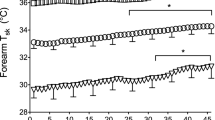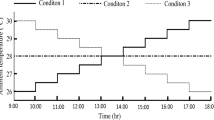Summary
The whole body sweating response was measured at rest in eight women during the follicular (F) and the luteal (L) phases of the menstrual cycle. Subjects were exposed for 30-min to neutral (N) environmental conditions [ambient temperature (T a) 28°C] and then for 90-min to warm (W) environmental conditions (Ta, 35°C) in a direct calorimeter. At the end of the N exposure, tympanic temperature (T ty) was 0.18 (SEM 0.06)°C higher in the L than in the F phase (P<0.05), whereas mean skin temperature (\(\bar T_{{\text{sk}}}\)) was unchanged. During W exposure, the time to the onset of sweating as well as the concomitant increase in body heat content were similar in both phases. At the onset of sweating, the tympanic threshold temperature (T ty, thresh) was higher in the L phase [37.18 (SEM 0.08)°C] than in the F phase [36.95 (SEM 0.07)°C;P<0.01]. The magnitude of the shift inT ty, thresh [0.23 (SEM 0.07)°C] was similar to the L-F difference inT ty observed at the end of the N exposure. The mean skin threshold temperature was not statistically different between the two phases. The slope of the relationship between sweating rate andT ty was similar in F and L. It was concluded that the internal set point temperature of resting women exposed to warm environmental conditions shifted to a higher value during the L phase compared to the F phase of the menstrual cycle; and that the magnitude of the shift corresponded to the difference in internal temperature observed in neutral environmental conditions between the two phases.
Similar content being viewed by others
References
Abraham GE, Manlimos FS, Garza R (1977) Handbook of radioimmuno-assay. In: Abraham GE (ed) chapt. 20. Dekker, New York, pp 591–656
Bittel J, Henane R (1975) Comparison of thermal exchanges in men and women under neutral and hot conditions. J Physiol (Lond) 250:475–489
Bonjour J-P, Weld HJ, Jéquier E (1976) Etude calorimétrique des consignes thermorégulatrices au déclenchement de la sudation et au cours du cycle menstruel. J Physiol (Paris) 72:181–204
Cannon GC, Dinarello CA (1985) Increased plasma interleukin-1 activity in women after ovulation. Science 227:1247–1249
Cunningham DJ, Cabanac M (1971) Evidence from behavioral thermoregulatory responses of a shift in set point temperature related to the menstrual cycle. J Physiol (Paris) 63:236–238
Dagnelie P (1973) Théorie et méthode statistiques, vol. 1. Les Presses Agronomiques de Gembloux. Gembloux, Belgium, pp 81–86
Durnin JVGA, Wormersley J (1974) Body fat assessed from total body density and its estimation from skinfold thickness: measurements on 481 men and women aged from 16 to 76 years. Br J Nutr 32:77–97
Frascarolo P, Schutz Y, Jéquier E (1990) Decreased thermal conductance during the luteal phase of the menstrual cycle in women. J Appl Physiol 69:2029–2033
Frye AJ, Kamon E, Webb M (1982) Responses of menstrual women, amenorrheal women, and men to exercise in a hot, dry environment. Eur J Appl Physiol 48:279–288
Hardy JD, DuBois EF (1938) The technic of measuring radiation and convection. J Nutr 15:461–475
Hessemer V, Bruck K (1985a) Influence of menstrual cycle on shivering, skin blood flow, and sweating responses measured at night. J Appl Physiol 59:1902–1910
Hessemer V, Bruck K (1985b) Influence of menstrual cycle on thermoregulatory, metabolic, and heart rate responses to exercise at night. J Appl Physiol 59:1911–1917
Jéquier E (1981) Long-term measurement of energy expenditure in man: direct or indirect calorimetry. In: Björntorp P, Cairella M, Howard AN (eds) Recent advances in obesity research III, Libbey, London, pp 130–135
Jéquier E, Felber J-P (1987) Indirect calorimetry. Clin End Metab 1:911–935
Kolka MA, Stephenson LA (1989) Control of sweating during the human menstrual cycle. Eur J Appl Physiol 58:890–895
Mitchell JW, Nadel ER, Stolwijk JAJ (1972) Respiratory weight losses during exercise. J Appl Physiol 32:474–476
Nakayama T, Suzuki M, Ishizuka N (1975) Action of progesterone on preoptic thermosensitive neurones. Nature 258:80
Spinnler G, Jéquier E, Favre R, Dolivo M, Vannotti A (1973) Human calorimeter with a new type of gradient layer. J. Appl Physiol 35:158–165
Stephenson LA, Kolka MA (1985) Menstrual cycle phase and time of day alter reference signal controlling arm blood flow and sweating. Am J Physiol 249 (Regulatory Integrative Comp Physiol 18): R186-R191
Wells CL, Horvath SM (1973) Heat stress responses related to the menstrual cycle. J Appl Physiol 35:1–5
Author information
Authors and Affiliations
Rights and permissions
About this article
Cite this article
Frascarolo, P., Schutz, Y. & Jéquier, E. Influence of the menstrual cycle on the sweating response measured by direct calorimetry in women exposed to warm environmental conditions. Europ. J. Appl. Physiol. 64, 449–454 (1992). https://doi.org/10.1007/BF00625066
Accepted:
Issue Date:
DOI: https://doi.org/10.1007/BF00625066




